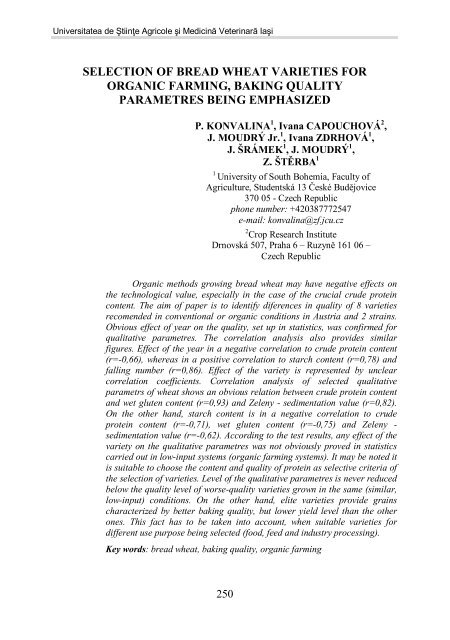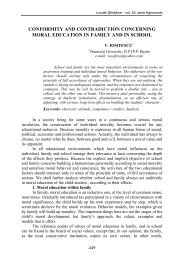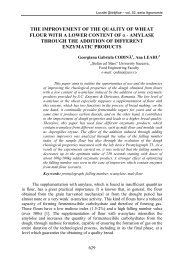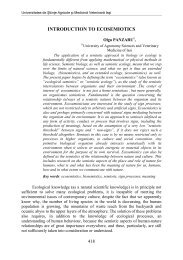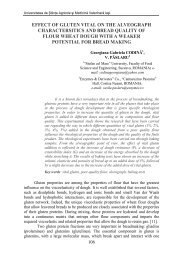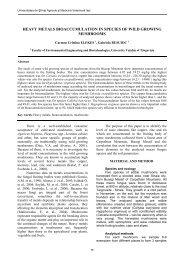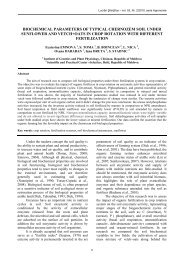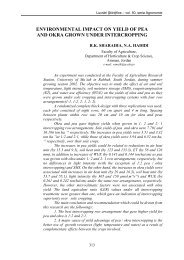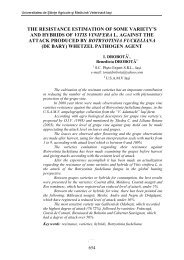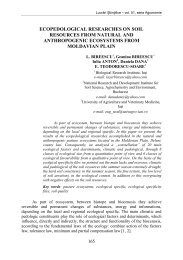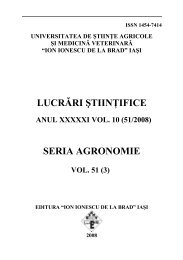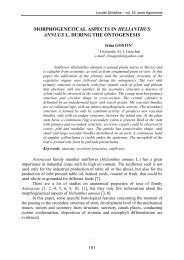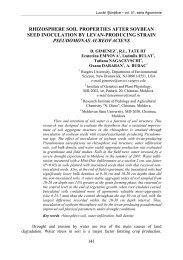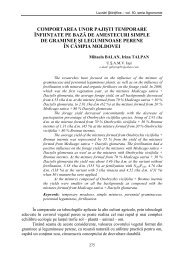selection of bread wheat varieties for organic farming, baking quality ...
selection of bread wheat varieties for organic farming, baking quality ...
selection of bread wheat varieties for organic farming, baking quality ...
Create successful ePaper yourself
Turn your PDF publications into a flip-book with our unique Google optimized e-Paper software.
Universitatea de Ştiinţe Agricole şi Medicină Veterinară Iaşi<br />
SELECTION OF BREAD WHEAT VARIETIES FOR<br />
ORGANIC FARMING, BAKING QUALITY<br />
PARAMETRES BEING EMPHASIZED<br />
P. KONVALINA 1 , Ivana CAPOUCHOVÁ 2 ,<br />
J. MOUDRÝ Jr. 1 , Ivana ZDRHOVÁ 1 ,<br />
J. ŠRÁMEK 1 , J. MOUDRÝ 1 ,<br />
Z. ŠTĚRBA 1<br />
1<br />
University <strong>of</strong> South Bohemia, Faculty <strong>of</strong><br />
Agriculture, Studentská 13 České Budějovice<br />
370 05 - Czech Republic<br />
phone number: +420387772547<br />
e-mail: konvalina@zf.jcu.cz<br />
2 Crop Research Institute<br />
Drnovská 507, Praha 6 – Ruzyně 161 06 –<br />
Czech Republic<br />
Organic methods growing <strong>bread</strong> <strong>wheat</strong> may have negative effects on<br />
the technological value, especially in the case <strong>of</strong> the crucial crude protein<br />
content. The aim <strong>of</strong> paper is to identify diferences in <strong>quality</strong> <strong>of</strong> 8 <strong>varieties</strong><br />
recomended in conventional or <strong>organic</strong> conditions in Austria and 2 strains.<br />
Obvious effect <strong>of</strong> year on the <strong>quality</strong>, set up in statistics, was confirmed <strong>for</strong><br />
qualitative parametres. The correlation analysis also provides similar<br />
figures. Effect <strong>of</strong> the year in a negative correlation to crude protein content<br />
(r=-0,66), whereas in a positive correlation to starch content (r=0,78) and<br />
falling number (r=0,86). Effect <strong>of</strong> the variety is represented by unclear<br />
correlation coefficients. Correlation analysis <strong>of</strong> selected qualitative<br />
parametrs <strong>of</strong> <strong>wheat</strong> shows an obvious relation between crude protein content<br />
and wet gluten content (r=0,93) and Zeleny - sedimentation value (r=0,82).<br />
On the other hand, starch content is in a negative correlation to crude<br />
protein content (r=-0,71), wet gluten content (r=-0,75) and Zeleny -<br />
sedimentation value (r=-0,62). According to the test results, any effect <strong>of</strong> the<br />
variety on the qualitative parametres was not obviously proved in statistics<br />
carried out in low-input systems (<strong>organic</strong> <strong>farming</strong> systems). It may be noted it<br />
is suitable to choose the content and <strong>quality</strong> <strong>of</strong> protein as selective criteria <strong>of</strong><br />
the <strong>selection</strong> <strong>of</strong> <strong>varieties</strong>. Level <strong>of</strong> the qualitative parametres is never reduced<br />
below the <strong>quality</strong> level <strong>of</strong> worse-<strong>quality</strong> <strong>varieties</strong> grown in the same (similar,<br />
low-input) conditions. On the other hand, elite <strong>varieties</strong> provide grains<br />
characterized by better <strong>baking</strong> <strong>quality</strong>, but lower yield level than the other<br />
ones. This fact has to be taken into account, when suitable <strong>varieties</strong> <strong>for</strong><br />
different use purpose being selected (food, feed and industry processing).<br />
Key words: <strong>bread</strong> <strong>wheat</strong>, <strong>baking</strong> <strong>quality</strong>, <strong>organic</strong> <strong>farming</strong><br />
250
Lucrări Ştiinţifice – vol. 51, seria Agronomie<br />
Organic (low-input) <strong>farming</strong> system is described as a <strong>farming</strong> system<br />
connected with a limited amount <strong>of</strong> nutrients (nitrogen especially) and absence <strong>of</strong><br />
the split nitrogen application [KÖPKE, 2005]. The early spring ability <strong>of</strong> nitrogen<br />
absorbtion is the main problem <strong>of</strong> growing <strong>of</strong> winter <strong>varieties</strong>; cold soil is<br />
characterized by a low microbial activity. The nutrient mineralization (<strong>of</strong> nitrogen,<br />
especially) is limited in this period [MOUDRÝ, 2003]. The efficient nitrogen<br />
absorbtion is also very important from the point <strong>of</strong> view <strong>of</strong> the <strong>quality</strong> <strong>of</strong> yield and<br />
evolution <strong>of</strong> plants in early stages <strong>of</strong> growth [REENTS, 2002].<br />
Cultivars should there<strong>for</strong>e have the ability to per<strong>for</strong>m under a low input <strong>of</strong><br />
<strong>organic</strong> fertilizers, a good root system, the ability to interact with beneficial soil<br />
microorganisms and to suppress weeds, and the ability to produce a healthy crop<br />
and healthy propagules [LAMERTS van BUEREN et al., 2002, 2003].<br />
Organic yield is about 20-30 % lower than the conventional [MOUDRÝ,<br />
1997; MÄDER et al., 2002; LAMMERTS van BUEREN, 2002]. The <strong>quality</strong> and<br />
stability <strong>of</strong> the yield are the main priorities <strong>for</strong> <strong>organic</strong> <strong>farming</strong> which does not lay<br />
stress on the quantity <strong>of</strong> production. Farmers usually need to grow “reliable“ and<br />
“solid“ <strong>varieties</strong> which are able to tolerate potential fluctuations in the weather and<br />
the potential pressure <strong>of</strong> diseases; they must in any case be able to provide<br />
sufficient yield <strong>of</strong> grains and straw [LAMMERTS van BUEREN, 2002].<br />
The high <strong>baking</strong> <strong>quality</strong> <strong>of</strong> the <strong>organic</strong> <strong>varieties</strong> is characterized by the<br />
proportion and total content <strong>of</strong> crude protein, high value <strong>of</strong> the Zeleny -<br />
sedimentation value, flour binding capacity and flour yield, Falling number and test<br />
weight. The <strong>baking</strong> <strong>quality</strong> <strong>of</strong> <strong>wheat</strong> is a complex feature; the breeding <strong>of</strong> such<br />
<strong>varieties</strong> (to a high <strong>quality</strong>) is a long and difficult process [FOSSATI et al., 2005].<br />
Organic methods <strong>of</strong> <strong>farming</strong> may have negative effects on the technological value,<br />
especially in the case <strong>of</strong> the crucial crude protein content [MOUDÝ & PRUGAR,<br />
2002].<br />
Modern cultivars <strong>of</strong> <strong>wheat</strong> do not satisfy all the requirements and demands<br />
<strong>of</strong> <strong>organic</strong> agriculture. There<strong>for</strong>e, more attention should be given to the breeding <strong>of</strong><br />
specific cultivars adapted to the agronomic conditions on <strong>organic</strong> farms and<br />
complying with the philosophy <strong>of</strong> <strong>organic</strong> <strong>farming</strong> [LAMMERTS van BUEREN,<br />
2002]. Nowadays, new breeding programmes are emerging because the<br />
conventional <strong>varieties</strong> <strong>of</strong> <strong>bread</strong> <strong>wheat</strong> have a very different genetic background<br />
[KUNZ & KARUTZ, 1991]. LAMMERTS van BUEREN et al. [2003] points out<br />
that, in order to avoid the use <strong>of</strong> chemical fertilizers and pesticides in <strong>organic</strong><br />
agriculture, agroecological principles should be applied to enhance the selfregulatory<br />
capacity <strong>of</strong> the agroecosystems. Organic farmers require cultivars that<br />
can be multiplied and grown in the <strong>organic</strong> <strong>farming</strong> system with no undue negative<br />
effect on the health and function <strong>of</strong> the agroecosystem [KUNZ & KARUTZ, 1991].<br />
The aim <strong>of</strong> paper is to identify diferences in <strong>quality</strong> <strong>of</strong> <strong>varieties</strong> recomended<br />
in conventional or <strong>organic</strong> conditions in Austria and showed that the system <strong>of</strong><br />
variety certification in <strong>organic</strong> <strong>farming</strong> should be different from conventional one.<br />
251
Universitatea de Ştiinţe Agricole şi Medicină Veterinară Iaşi<br />
MATERIAL AND METHOD<br />
In the experimental years 2006 and 2007, with 8 <strong>varieties</strong> (Capo, Eriwan,<br />
Element, Eur<strong>of</strong>it, Clever, Ludwig, Epsilon, Element) and 2 strains (SE 304/05, SE<br />
320/05) <strong>of</strong> <strong>bread</strong> <strong>wheat</strong> comes from conventional and breeding programmes <strong>of</strong> Austrian<br />
breeding stations in small plot trials (10 m 2 ) with two replications were executed at<br />
location in South Bohemia, experimental fields <strong>of</strong> University <strong>of</strong> South Bohemia in České<br />
Budějovice (USB). The characteristics <strong>of</strong> the trial station: altitude <strong>of</strong> 388 m; mean air<br />
temperature <strong>of</strong> 8,2 °C; total precipitation <strong>of</strong> 620 mm; sunshine duration <strong>of</strong> 1564,3 hours;<br />
pH (CaCl 2 ) <strong>of</strong> 6,3; P - 138 mg.kg -1 ; K - 155 mg.kg -1 ; Mg - 163 mg.kg -1 ; Ca - 1557 mg.kg -<br />
1 . The experiments were carried out in low input growing system (practically not<br />
certificied <strong>organic</strong> <strong>farming</strong> system), without mineral fertilizers and pesticides. The<br />
<strong>for</strong>going crop was legumes-ceral mixture, in regular periods <strong>of</strong> 4 years was dose <strong>of</strong><br />
manure. The <strong>quality</strong> parametres were analised by NIR spectroscopy system. The data<br />
were analysed in STATISTICA programme.<br />
RESULTS AND DISCUSSIONS<br />
Ten <strong>varieties</strong> <strong>of</strong> <strong>bread</strong> <strong>wheat</strong> were tested; according to the achieved average<br />
figures, the volume weight was considered as a stable feature (CV 2,9% - 2006,<br />
2,7% - 2007). It was reduced under the level <strong>of</strong> 737,3 g.l -1 . On the other hand, the<br />
yield was fluctuating (nearly 20 % <strong>of</strong> CV). The average yield achieved 3,79 t/ha in<br />
2006 and 4,51 t t.ha -1 (Table 1). There were considerable differences between the<br />
<strong>varieties</strong>; e.g. Strain 320/05 variety provided the yield <strong>of</strong> 5,757 t.ha -1 , contrary to<br />
Econom variety which provided the yield <strong>of</strong> 2,102 t.ha -1 . Crude protein yield per<br />
hectare showed very interesting figures too (table 1). Capo variety achieved the<br />
highest figures in both tested years. On the other hand, Element variety, which has<br />
the highest crude protein content and the highest <strong>baking</strong> <strong>quality</strong> provided very low<br />
yield and low crude protein yield (table 1).<br />
Table 1<br />
Grain and crude protein yield, hectoliter weight<br />
Number <strong>of</strong> spike<br />
(1m 2 Yield (t.ha -1 Hectoliter weight Crude protein<br />
)<br />
)<br />
(g.l -1 ) yield (kg.ha -1 )<br />
Variety<br />
Year<br />
06 07 06 07 06 07 06 07<br />
Capo 307 446 4,47 4,935 764 810 554 498<br />
Eriwan 258 303 3,670 4,115 764 791 414 386<br />
Element 214 247 2,705 3,684 733 804 392 412<br />
Eur<strong>of</strong>it 218 350 4,213 4,402 721 791 560 431<br />
Clever 344 412 2,515 4,652 698 738 266 409<br />
Ludwig 266 392 3,585 5,674 711 785 408 573<br />
Epsilon 256 355 4,305 4,679 727 770 512 430<br />
Econom 244 311 4,748 2,102 718 761 508 193<br />
304/05 233 416 4,015 5,105 733 779 538 484<br />
320/05 356 392 3,683 5,757 744 780 408 558<br />
mean 269,6 362,4 3,79 4,51 731,3 780,9 456 437<br />
SD 49,978 61,256 0,726 1,061 21,417 20,979 94,017 106,8<br />
CV (%) 18,5 16,9 19,2 23,5 2,9 2,7 20,6 24,4<br />
Upper quartile <strong>of</strong> crude protein yield (2006 = 538 kg.ha -1 , 2007 = 498 kg.ha -1 )<br />
252
Lucrări Ştiinţifice – vol. 51, seria Agronomie<br />
The crop stand had, there<strong>for</strong>e, the limited ability <strong>of</strong> the production <strong>of</strong><br />
nitrogenous elements. SLAFER’s hypothesis [SLAFER et al., 1990] also confirms<br />
these results. He states the fact that the increase <strong>of</strong> the yield level (caused by the<br />
breeding process) leads to “a dilution” <strong>of</strong> nitrogen and reduction <strong>of</strong> the nitrogen<br />
concentration in grain.<br />
There was any obvious influence <strong>of</strong> the genotype proved neither on the total<br />
yield, nor on the volume weight during the process <strong>of</strong> <strong>bread</strong> <strong>wheat</strong> growing in lowinput<br />
<strong>farming</strong> system (table 2). On the other hand, there was the evident strong<br />
effect <strong>of</strong> the year on the volume weight (p < 0,01) (it was caused by the longlasting<br />
rainy weather in the harvest period). ZIMOLKA et al. [2005] also confirms<br />
this fact.<br />
Table 2<br />
ANOVA, values <strong>of</strong> the test criterion F (factors genotype and year - parametres<br />
crude protein yield, grain yield, hectoliter weight)<br />
Factor<br />
Parametre<br />
Crude protein yield Grain yield Hectoliter weight<br />
Genotype 0,933 n 0,580 n 0,569 n<br />
Year 0,1708 n 3,13 n 27,372 *<br />
Notes: * statistically significant α = 0,01; n – statistically insignificant<br />
According to table 3, the selected parameters <strong>of</strong> the <strong>baking</strong> <strong>quality</strong> <strong>of</strong> the<br />
<strong>varieties</strong>, grown in low-input <strong>farming</strong> system are considered as the most stable<br />
ones. Starch content is considered as the most stable parameter (CV 1,4 % - 2006,<br />
1,3 % - 2007) contrary to falling number (the most fluctuating feature, especially in<br />
2006 – rainy year, CV = 47,2 %). Zeleny sedimentation value is another parameter<br />
influenced by the reaction <strong>of</strong> the <strong>varieties</strong> grown in low nitrogen-input <strong>farming</strong><br />
system. There are considerable differences between the <strong>varieties</strong>; CV = 24,1 % in<br />
2006, CV = 29,2 % in 2007. Concerning crude protein content and wet gluten<br />
content, they are not so fluctuating ones.<br />
There were favourable weather conditions <strong>for</strong> crude protein content in 2006<br />
[BUREŠOVÁ, PALÍK, 2006]. It reached 12,6 % in average in 2006 and 9,7 % in<br />
average in 2007. There were the <strong>varieties</strong> providing extraordinary values, e.g.<br />
Element variety (14,5% - 2006 and 11,2% - 2007) and the <strong>varieties</strong> showing<br />
below-average figures, e.g. Clever variety (10,6% - 2006 and 8,8% - 2007).<br />
According to the example mentioned above, the <strong>selection</strong> <strong>of</strong> an unsuitable variety<br />
could have the negative effect on protein content (3,9 % in 2006 or 2,4 % in 2007)<br />
in low-input <strong>farming</strong> system. Element variety had the highest wet gluten content in<br />
2006 and 2007 too, from the point <strong>of</strong> view <strong>of</strong> the correlation coefficient (r = 0 ,93)<br />
between crude protein content and wet gluten content (table 3).<br />
Zeleny sedimentation value characterises viscoelastic qualities <strong>of</strong> proteins<br />
and the <strong>quality</strong> <strong>of</strong> proteins; it allows the fermentation process in dough [ZIMOLKA<br />
et al., 2005]. There is the positive correlation between crude protein content and<br />
Zeleny sedimentation value (r = 0,82). Element variety is also supposed to be the<br />
most perspective one from the point <strong>of</strong> view <strong>of</strong> the protein duality (51 ml – 2006<br />
and 38 ml – 2007). On the other hand, Clever variety has the lowest figures (24 ml<br />
253
Universitatea de Ştiinţe Agricole şi Medicină Veterinară Iaşi<br />
– 2006 and 12 ml – 2007). Starch content increased in less favourable year <strong>for</strong><br />
protein creation (there was no obvious negative dependance between protein<br />
content and starch content, r = -0,71). In 2006, the variety which contained the least<br />
crude protein (Clever) had the highest starch content. Falling number was<br />
obviously influenced (p < 0,01) by the year; in 2006, the harvest was 2 weeks later<br />
because <strong>of</strong> rainy weather and a lot <strong>of</strong> <strong>varieties</strong> fall short <strong>of</strong> the requirements <strong>of</strong> the<br />
<strong>quality</strong> norm be embedded in the <strong>quality</strong> group B – <strong>bread</strong> (160 s.) [ZIMOLKA et<br />
al., 2005]. The example <strong>of</strong> 2006 may demonstrate the differences in resistance to<br />
lodging between the <strong>varieties</strong>. E.g. Strain 320/05 variety reached the value <strong>of</strong> 217<br />
s. in 2006 and Econom variety was characterized by the low falling number (62 s.)<br />
in the same land-climatic conditions and the same year (table 3).<br />
Table 3<br />
Selected parametres <strong>of</strong> gaking <strong>quality</strong><br />
Variety<br />
Crude<br />
protein<br />
content<br />
(%)<br />
Wet gluten<br />
content<br />
(%)<br />
Zeleny –<br />
sedimentat<br />
ion value<br />
(ml)<br />
Starch<br />
content<br />
(%)<br />
Falling<br />
number (s)<br />
Year<br />
06 07 06 07 06 07 06 07 06 07<br />
Capo 12,4 10,1 24,6 18,0 47 28 64,9 67,6 95 217<br />
Eriwan 11,3 9,4 20,7 15,5 39 29 63,8 66,1 204 272<br />
Element 14,5 11,2 29,1 20,1 51 38 63,3 66,8 124 354<br />
Eur<strong>of</strong>it 13,3 9,8 22,3 17,2 34 30 64,9 65,1 111 305<br />
Clever 10,6 8,8 21,8 17,0 24 12 65,5 66,5 76 268<br />
Ludwig 11,4 10,1 22,8 18,4 29 28 64,8 68,1 65 407<br />
Epsilon 11,9 9,2 23,6 17,0 30 23 64,1 66,1 79 325<br />
Econom 10,7 9,2 20,9 16,6 31 18 64,9 66,6 62 330<br />
304/05 13,4 9,5 25,9 16,3 46 21 62,7 65,6 147 227<br />
320/05 11,1 9,7 20,9 17,3 38 22 65,0 67,0 217 329<br />
mean 12,6 9,7 23,3 17,3 36,9 24,9 64,4 66,6 118 303<br />
SD 1,30 0,67 2,67 1,27 8,88 7,26 0,88 0,89 55,7 58,4<br />
CV (%) 10,4 6,9 11,5 7,31 24,1 29,2 1,4 1,3 47,2 19,2<br />
According to table 3, the stability <strong>of</strong> the selected parameters <strong>of</strong> the <strong>baking</strong><br />
<strong>quality</strong> <strong>of</strong> the <strong>varieties</strong>, grown in low-input <strong>farming</strong> systems is evident. Starch<br />
content is the most stable parameter (CV 1,4 % - 2006, 1,3 % - 2007). Falling<br />
number was the least stable (the most fluctuating) parameter, especially in 2006<br />
(CV = 47,2 %). Zeleny sedimentation value is another parameter influenced by the<br />
reaction <strong>of</strong> the <strong>varieties</strong> in low nitrogen-input <strong>farming</strong> system. There are<br />
considerable differences between the <strong>varieties</strong>; CV = 24,1 % in 2006, CV = 29,2%<br />
in 2007. Concerning crude protein content and wet gluten content, the fluctuation is<br />
not so important.<br />
Concerning qualitative parameters, there is the obvious influence <strong>of</strong> the year<br />
(table 4). The genotype has any obvious effect neither on crude protein content, nor<br />
on the other <strong>baking</strong> <strong>quality</strong> parameters. The amount <strong>of</strong> protein complex <strong>of</strong> <strong>wheat</strong><br />
grain depends on the environmental factors, not on the genotype. TRIOBI et al.<br />
[2000] states the finding that the variety has a small effect on the proportion <strong>of</strong><br />
nitrogenous elements (not more than 4 %).<br />
254
Lucrări Ştiinţifice – vol. 51, seria Agronomie<br />
Table 4<br />
ANOVA, values <strong>of</strong> the test criterion F (factors genotype and year - selected<br />
parametres <strong>of</strong> <strong>baking</strong> <strong>quality</strong>)<br />
Quality parameter<br />
Zeleny –<br />
Factor Crude protein Wet gluten<br />
Falling<br />
sedimentation Starch content<br />
content content<br />
number<br />
value<br />
Genotype 0,525 n 0,342 n 1,122 n 0,378 n 0,122 n<br />
Year 26,564* 40,475* 11,217* 29,239* 52,838*<br />
Notes: * statistically significant α = 0,01 (*) ; statistically insignificant ( n )<br />
The correlation analysis also provides similar figures (table 5). The effect <strong>of</strong><br />
the year is in the negative correlation to the protein content (r = -0,66), to wet<br />
gluten content (r = -0,46) and it is in the positive correlation to starch content (r =<br />
0,78) and to falling number (r = 0,86). The effect <strong>of</strong> the variety is represented by<br />
low and unobvious correlation coefficients.<br />
Table 5<br />
Correlation analysis <strong>of</strong> selected qualitative parameters versus factor <strong>of</strong> year and<br />
variety<br />
Factor<br />
Crude<br />
protein<br />
content<br />
Wet<br />
gluten<br />
content<br />
Zeleny –<br />
sedimentation<br />
value<br />
Starch<br />
content<br />
Alveograph<br />
energy<br />
Falling<br />
number<br />
Year -0,66* -,075* -0,46 n 0,78* -0,44 n 0,86*<br />
Variety 0,01 n 0,10 n 0,01 n -0,16 n 0,06 0,10 n<br />
Statistically significant correlation at α < 0,05 (*); statistically insignificant ( n )<br />
Correlation analysis <strong>of</strong> selected qualitative parametrs <strong>of</strong> <strong>wheat</strong> (table 6)<br />
shows the obvious relation between crude protein content and wet gluten content (r<br />
= 0,93) and Zeleny - sedimentation value (r = 0,82). The demonstrated figures are<br />
in accordance with Krejčířová’s results [KREJČÍŘOVÁ et al., 2006]. She states the<br />
fact that there are more close relations in low-input <strong>farming</strong> system than in<br />
conventional one. On the other hand, starch content is in the negative correlation to<br />
crude protein content (r = -0,71), wet gluten content (r = -0,75) and Zeleny -<br />
sedimentation value (r = -0,62). The results have not proposed any obvious effect<br />
<strong>of</strong> the variety on the qualitative parameters in low-input <strong>farming</strong> system.<br />
Table 6<br />
Correlation analysis <strong>of</strong> selected qualitative parametrs <strong>of</strong> <strong>wheat</strong><br />
C W Z S A F<br />
Crude protein content (C) 1<br />
Wet gluten content (W) 0,93 * 1<br />
Zeleny – sedimentation value (Z) 0,82* 0,77 * 1<br />
Starch content (S) -0,71 n -0,75 n -0,62 n 1<br />
Alveograph energy (A) 0,70 * 0,75 * 0,66 * -0,38 n 1<br />
Falling number (F) -0,53 * -0,66 ** -0,25 n 0,64 * -0,49 n 1<br />
Statistically significant correlation at α < 0,05 (*);α < 0,01 (**);statistically insignificant ( n )<br />
255
Universitatea de Ştiinţe Agricole şi Medicină Veterinară Iaşi<br />
CONCLUSIONS<br />
When evaluating the results, we may demonstrate the following findings.<br />
The <strong>baking</strong> <strong>quality</strong> is reduced in <strong>organic</strong> (low-input) <strong>farming</strong> system; crude protein<br />
content and Zeleny sedimentation value decrease. On the other hand, starch content<br />
is not influenced by the <strong>farming</strong> system. Resistance to lodging, expressed in falling<br />
number figures, is influenced by the reaction <strong>of</strong> the variety in certain conditions in<br />
certain years.<br />
The <strong>selection</strong> <strong>of</strong> elite <strong>varieties</strong> (with high protein content and favourable<br />
Zeleny sedimentation values) can be recommended <strong>for</strong> low-input <strong>farming</strong> system<br />
(e.g. Element variety). Elite <strong>varieties</strong> respond to the absence <strong>of</strong> the supportive<br />
instruments (soluble nitrogenous fertilizers) by the reduction <strong>of</strong> crude protein<br />
content. However, the reduction <strong>of</strong> crude protein content is not as considerable as<br />
the reduction <strong>of</strong> crude protein content in case <strong>of</strong> less qualitative variety grown in<br />
the same conditions. On the other hand, elite <strong>varieties</strong> provide grains characterized<br />
by better <strong>baking</strong> <strong>quality</strong>, but lower yield level than the other ones. This fact has to<br />
be taken into account, when suitable <strong>varieties</strong> <strong>for</strong> different use purpose being<br />
selected (food, feed and industry processing).<br />
Acknowledgement: This work was supported by the MSM 6007665806<br />
and grant <strong>of</strong> National agency <strong>of</strong> agricultural research NAZV QG 50034.<br />
BIBLIOGRAPHY<br />
1. Burešová, I., Palík, S., 2006 – Kvalita potravinářských obilovin ze sklizně 2006. In:<br />
Sborník z konference Jakost obilovin 2006, 9.11.2006, Kroměříž, pp. 6 -12.<br />
2. Fossati, D., Kleijer, G., Brabant, C., 2005 - Practical breeding <strong>for</strong> <strong>bread</strong> <strong>quality</strong>. In:<br />
Proceedings <strong>of</strong> the Cost Susvar/ECO-PB Workshop on Organic plant Breeding<br />
Strategies and the use <strong>of</strong> Molecular Markers. 17-19. January, Driebergen, The<br />
Netherlands, pp. 31-35.<br />
3. Köpke, U., 2005 - Crop ideotypes <strong>for</strong> <strong>organic</strong> cereal cropping systems. In: Proceedings <strong>of</strong><br />
the COST SUSVAR/ECO-PB Workshop on Organic Plant Breeding Strategies and<br />
the Use <strong>of</strong> Molecular Markers. 17.-19. January, Driebergen, The Netherlands, pp.13-<br />
16.<br />
4. Krejčířová, L., Capouchová, I., Petr, J., Bicanová, E., Kvapil, R., 2006 - Protein<br />
composition and <strong>quality</strong> <strong>of</strong> winter <strong>wheat</strong> from <strong>organic</strong> and conventional <strong>farming</strong>.<br />
Žembdirbysté, 93, pp. 285-296.<br />
5. Kunz, P., Karutz, C., 1991 - Pflanzenzüchtung dynamisch. Die Züchtung<br />
standortpflangepasster Weizen und Dinkelsorten. Erfahrungen, Ideen, Projekten.<br />
Forschungslabor an Goetheanum, Dornach, Switzerland, 164 pp.<br />
6. Lammerts van Bueren, E.T., Struik, P.C., Tiemens-Hulscher, M., Jacobsen, E., 2003 -<br />
Concepts <strong>of</strong> intrinsic value and integrity <strong>of</strong> plants in <strong>organic</strong> plant breeding and<br />
propagation. Crop Science 43: 1922-1929.<br />
7. Lammerts van Bueren, E. T., 2002 - Organic Plant Breeding and Propagation: Concepts<br />
and Strategies. PhD Thesis, Wageningen University, The Netherland, 196 p.<br />
8. Mäder, P., Fließbach, A., Dubois, D., Gunst, L., Fried, P., Niggli, U., 2002 - Soil fertility<br />
and biodiversity in <strong>organic</strong> <strong>farming</strong>. Science 296: 1694-1697.<br />
9. Moudrý, J., 1997 - Přechod na ekologický způsob hospodaření (Conversion to <strong>organic</strong><br />
<strong>farming</strong>). IVV MZe, Praha, 48 pp.<br />
256
Lucrări Ştiinţifice – vol. 51, seria Agronomie<br />
10. Moudrý, J., 2003 - Polní produkce (Field production). In: URBAN, J., Šarapatka, B.<br />
(Eds.): Ekologické zemědělství. MŽP, Praha, pp. 103-126.<br />
11. Moudrý J., Prugar, J., 1999 - Kvalita rostlinných produktů ekologického zemědělství<br />
(Quality <strong>of</strong> bioproducts). Studijní in<strong>for</strong>mace ÚZPI, (5), 40 p.<br />
12. Reents, H, J., 2002 - Sorteneigenschaften und Züchtziele für Getraidearten im<br />
Ökologischen Landbau. Workshop: Züchtung für den Ökolandbau, Hannover<br />
(http://orgprint.org).<br />
13. Slafer, G. A., Andrade, F.H., Feingold, S.E., 1990 - Genetic improvement <strong>of</strong> <strong>bread</strong> <strong>wheat</strong><br />
(Triticum aestivum L.) in Argentina: relationship between nitrogen and dry matter.<br />
Euphytica 50: 63-71.<br />
14. Triboi, E., Abad, A., Michelena, A., Lloveras, J., Ollier, J.L. and Daniel, C., 2000 -<br />
Environmental effects on the <strong>quality</strong> <strong>of</strong> two <strong>wheat</strong> genotypes: I. quantitative and<br />
qualitative variation <strong>of</strong> storage proteins. Eur J Agron 13: 47-64.<br />
15. Zimolka, J. et al., 2005 - Pšenice – pěstování, hodnocení a užití zrna. Pr<strong>of</strong>i Press, s.r.o.,<br />
Praha, 180 pp.<br />
257


